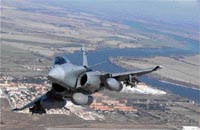
This year represents a period of consolidation for France's Rafale fighter programme. The Dassault-led design is in secured production for the French armed forces and in the last phase of a contest to supply Singapore with a new-generation interceptor, an opportunity which could deliver the type's first export success.
The Rafale International industry team, also comprising Snecma and Thales, has now received domestic orders for 120 aircraft, with its most recent success having been a December 2004 contract to deliver 59 Rafales to the French air force and navy from 2008-12.
The French air force will receive the majority of France's planned 294 Rafales, with 82 of its 234 aircraft now under contract and deliveries running at a rate of around one airframe per month. The service on 3 June accepted its first single-seat Rafale C in the F2 software standard, with this joining four two-seat Bs already supporting training activities at the air force's flight evaluation centre at Mont-de-Marsan.
A further nine C/Bs will have been delivered by year-end, forming the nucleus of the air force's first frontline unit to receive the type. To commence operational activities from Saint-Dizier airbase in September 2006, 1/7 Squadron will be equipped with five single and 15 two-seat fighters.
Dubbed an "omnirole" fighter by its developers, the Rafale is manufactured in three versions with 80% commonality: the air force's C and B variants; and the French navy's single-seat Rafale M carrierborne fighter.
Three software configurations are currently funded - the F1 air superiority standard in use by the navy since late 2001, and the F2 and F3 standards that will progressively add expanded ground-attack and multi-role mission capabilities.
The F2 standard now been introduced with the air force is set to achieve initial operational capability late this year, with full utility to follow the delivery of a software update in early 2006. The new configuration expands the F1's payload of MBDA-supplied Magic 2 and active radar-guided Mica EM air-to-air missiles and basic electronic warfare suite with enhanced ground attack, communications and self-defence capabilities.
Systems added include MBDA's infrared-guided Mica IR and Scalp-EG cruise missiles, Sagem's AASM modular air-to-surface missile and a Link 16 datalink. The F2 configuration also introduces Thales's passive front sector optronics suite, which comprises infrared search and track and TV sensors plus a laser range finder, and the Spectra integrated electronic warfare system.
Air force C/Bs will carry two Scalp-EGs on underwing pylons, with the M to deploy one from its centreline station. Nine test releases of Sagem's AASM powered air-to-surface weapon have also taken place from France's Cazaux test range, with a further three scheduled for the near future.
The navy has now operated the Rafale for over four years and completed several embarked deployments aboard the Charles de Gaulle since December 2001. However, formal entry into service was not declared until June 2004 with its Flotille 12 unit based at Landivisiau and a second squadron will not follow until at least 2007.
In total, the navy will receive 60 Rafales, with 38 of these ordered so far. All its aircraft will be Ms, with the service having scrapped a one-time plan to acquire some two-seat N variants after assessing the costs involved.
Operations of the navy's first 10 F1 aircraft have resulted in positive feedback and the navy "is now fully satisfied with this aircraft", says Pierre-Cyril Delanglade, the company's Rafale Director at Istres. These aircraft will be upgraded straight to the F3 software standard from early next decade, he adds.
Aircraft delivered after 2008 will be armed with MBDA's AM39 Exocet anti-ship and ASMP-A nuclear missiles and laser-guided bombs to be designated by the Thales-developed Damocles targeting pod and Sagem's Gerfaut helmet-mounted display. They will also receive Thales's Reco NG reconnaissance pod, a major production order for which is anticipated early next month.
It is the Rafale's Thales-developed RBE2 radar that will deliver the type's so-called omnirole capability, with this capable of conducting air-to-air, air-to-surface and anti-ship duties during a single sortie, and of providing mapping and fire control services against simultaneous targets.
The Rafale team is already promoting a post F3-standard enhancement to the current system, which will replace the RBE2 sensor's front end with an active electronically scanned array (AESA) offering expanded capability and reduced maintenance.
Describing the current AESA design as "mature, but not sustainable", Jean-Francois Ghignoni, Thales Airborne Systems' Rafale export programme manager, says: "By 2012 we will make it maintainable and affordable."
Other F3 weapons integration has already started using the navy's first production aircraft, with carrier survivability tests completed with the Exocet and the ASMP-A nuclear weapon, along with the Damocles targeting pod. Longer term, a notional F4 configuration is expected to introduce MBDA's Meteor beyond visual-range air-to-air missile.
Source: Flight Daily News
















